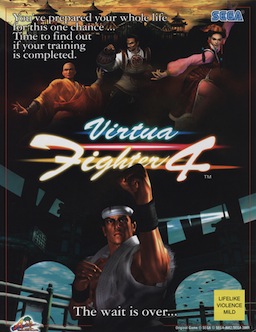Virtua Fighter 4: Evolution
| Virtua Fighter 4 | |
|---|---|
 |
|
| Developer(s) | Sega AM2 |
| Publisher(s) | Sega |
| Director(s) |
Yu Suzuki Toru Ikebuchi |
| Series | Virtua Fighter |
| Platform(s) | Arcade, PlayStation 2 |
| Release date(s) |
Arcade 2001 2002 (Evolution) 2004 (Final Tuned) PlayStation 2
|
| Genre(s) | Fighting game |
| Mode(s) | Up to 2 players simultaneously |
| Cabinet | Upright |
| Arcade system | Sega NAOMI 2 |
| Display | Horizontally oriented |
Virtua Fighter 4 (Japanese: バーチャファイター4 Hepburn: Bācha Faitā Fō?) is a fighting game by Sega. It is the fourth game in the Virtua Fighter series.
The game was first released in arcades on the NAOMI 2 board in 2001. A console port of Virtua Fighter 4, as well as that of Virtua Fighter 4: Evolution under the budget-priced "Greatest Hits" label, appeared on the Sony PlayStation 2 in 2002 and 2003, respectively.
In Japan, Virtua Fighter 4 is famous for spearheading and opening the market for internet functionality in arcades. VF.NET started in Japan in 2001, and since companies have created their own arcade networks, e-Amusement by Konami, NESiCAxLive by Taito and Square Enix, and ALL.Net by Sega and Bandai Namco.
A unique feature in Evolution was the ability to play in a tournament quest mode, where the concept was that the player was competing by traveling to various arcades, as opposed to role-playing as the player's chosen fighter. This mode was very popular due to the ability to buy cosmetic items to customize a character, as well as the ability to name a character. Many players of fighting games have unique styles; with the combination of various items allowing for vastly differing appearances a new depth of uniqueness was added. In addition, Sega took the top tournament players from the arcade version, and captured their style of play for the AI of a player's opponents for this mode. For example, playing against one Wolf character would be very different from playing another, because the actual player that character's AI was programmed to mimic had a unique play style.
...
Wikipedia
